
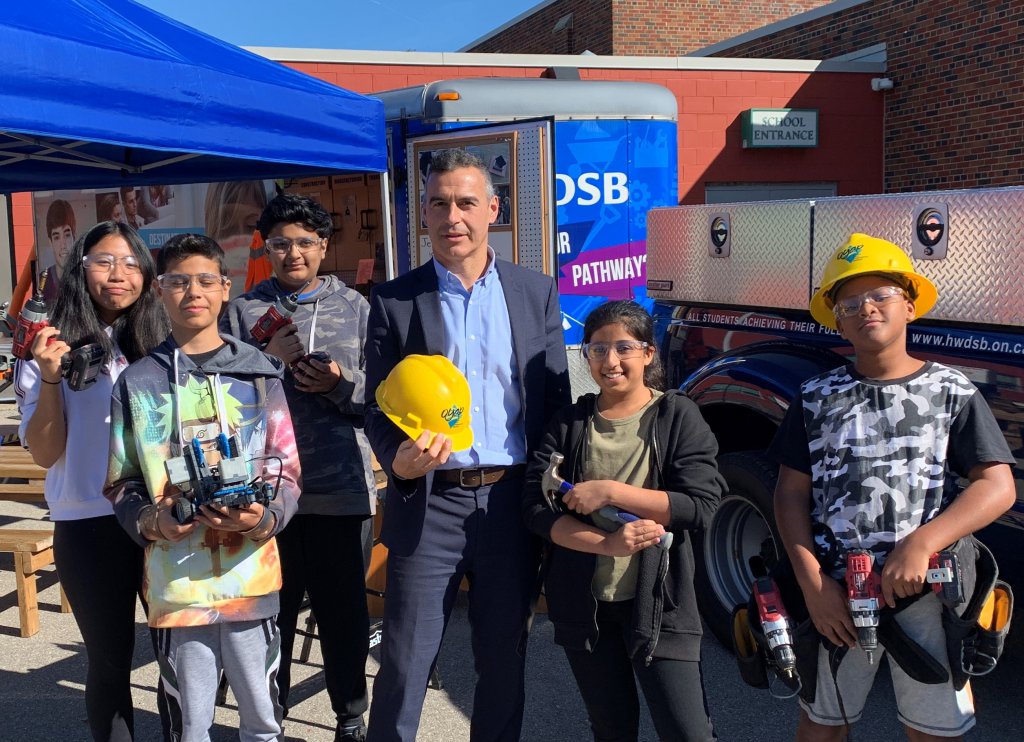 In 2018-19, Hamilton-Wentworth District School Board (HWDSB) continued to refine and deliver on the HWDSB Reimagined vision developed with community input. This vision has five priorities: Positive Culture and Well-being, Student Learning and Achievement, Effective Communication, School Renewal and Partnerships.
In 2018-19, Hamilton-Wentworth District School Board (HWDSB) continued to refine and deliver on the HWDSB Reimagined vision developed with community input. This vision has five priorities: Positive Culture and Well-being, Student Learning and Achievement, Effective Communication, School Renewal and Partnerships.
We continued to put a special focus on equity, as we reinforced our commitment to our High Priority Schools, launched our staff census, prepared for an employment equity audit and enhanced supports so that racialized and marginalized students, staff and families feel safe, supported and accepted in our schools.
You will sense this spirit of community and equity in our video outlining our Commitment to Equity. See a more detailed summary of our ongoing equity work on our Equity and Well-being web page.
Please find a summary of our work in 2018-19, as we moved toward our goals, adjusted course based on feedback and results, and developed our Board Annual Plan for 2019-20.
These are the ways we help curiosity, creativity and possibility come alive for our students, staff and community.
Positive Culture and Well-Being
We will build student and staff well-being through positive climate strategies and supportive relationships.
Progress in 2018-19
Goal: All students and staff feel, safe, supported and accepted.
Target #1: The number of students who feel safe, supported and accepted will increase by June 2020.
Strategies:
- Provide professional learning for staff on how to use student survey data, and anti-racism and anti-oppression strategies. School administrators will review school-level student and staff well-being data to identify strengths, surprises and next steps regarding the Positive Culture and Well-being priority of the School Annual Plan. Service Leaders will review system and department staff well-being data, within the context of department plans. Considering learning from Deep Diversity training and student voice, leaders will learn about using an anti-racism/anti-oppression framework for decision making and action. We expect this will positively impact relationships and climate.
- Leverage effective practices in schools that enhance student-staff relationships, including a focus on students identifying a caring adult, through the mental health strategy, We Help. We will support school administrators to set targets and use the continuous learning and improvement process, with a focus on positive culture and well-being. Schools will apply strategies from the We Help mental well-being initiative to enhance student-staff relationships. We will review approaches to bullying and other behaviours and develop tools to measure improved relationships.
- Implement the next phase of the High Priority Schools plans. Building on year one, we will look at the best fit when assigning school administrators, as we continue to make positive culture and well-being a focus in school plans. To provide resources where needed most, we will assign Early Child Development Support Educators to High Priority Schools among other services and resources. We will learn about identifying and removing barriers to success at high priority schools and enhance our focus on partnerships which support nutrition programs. At the time of the related Board report, staff were on target to have the number of students who feel safe, supported and accepted increase by June 2020.
Target #2: The number of staff feeling safe, supported and accepted will increase by June 2020.
Strategies:
- Provide professional learning on anti-racism and anti-oppression strategies. Like System Leaders, Service Leaders will learn about using an anti-racism/anti-oppression framework for decision making and action in departments. We expect this will improve relationships.
- Develop and implement a staff census to understand the diversity of our employee community. To understand staff diversity and how we reflect our community, staff will work with union leaders to develop the HWDSB Staff Census. This builds on diversity learning, will launch in spring 2019 and will be the only system survey of 2018-19.
- Develop and implement a strategic wellness and absence management plan. We will redefine this program to detail responsibility, training and HWDSB support for absent employees. We expect this will help staff attend work regularly and give supervisors guidance to support staff during the process. At the time of the related Board report, staff were on target to have the number of staff who feel safe, supported and accepted increase by June 2020.
Action Plan for 2019-20
Goal: All students and staff feel, safe, supported and accepted.
Target #1: The number of students who feel safe, supported and accepted will increase by June 2020.
Strategies:
- Provide differentiated professional learning on Emotion Coaching (i.e. Validation) to school staff, school leaders, and system support staff.
- Implement Emotion Coaching (ie. Validation), to enhance student-staff relationships (i.e. caring adult).
- Identified schools to implement Anti-racism/Anti-oppression (ARAO), Culturally Relevant and Responsive Pedagogy (CRRP) and Indigenous Cultural Safety (ICS) approaches.
Target #2: The number of staff feeling safe, supported and accepted will increase by June 2020.
Strategies:
- Provide professional learning to service leaders on human rights, systems of oppression and privilege, and implications within the workplace.
- Develop and implement an Employment Equity Action Plan from the Staff Census and Employment Process Review (Audit) recommendations.
- Implement the strategic wellness and absence management plan.
 |
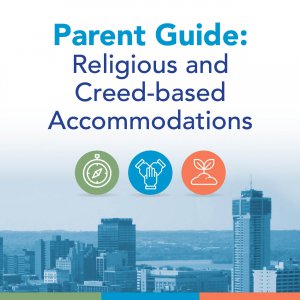 |
 |
| HWDSB Launches Staff Census, We All Count | Religious and Creed-based Accommodations | CC:ROSE Project Blooms into Indigenous Student Community |
Student Learning and Achievement
We will improve student learning and achievement through effective instructional strategies.
Progress in 2018-19
Goal #1: All students reading.
Target: At least 75 per cent of Grade 1 students achieving at or above provincial standard on their June report card.
Strategies:
- Investing in people. Provide professional learning on comprehensive literacy instruction, assessment and interventions for reading specialists, kindergarten and grade one Educators. If there are multiple, differentiated opportunities for professional learning, then educators will be able to deepen their understanding of how students learn to read and further develop their ability to implement evidence-based comprehensive literacy strategies and interventions.
- Leveraging effective practices. Leverage effective literacy practices in classrooms including a dedicated daily focus on reading. If educators utilize daily, dedicated, evidence-based comprehensive literacy strategies (including interventions) and effective assessment for learning practices then students will have a greater opportunity to become proficient readers.
- Refining measures of progress. Refine the measures used to monitor the progress students make towards becoming effective readers by the end of grade one. If educators utilize a continuum of reading comprehension and monitor reading comprehension levels for all students on a regular basis, then gaps in student learning will be identified and addressed in a timely manner.
- High Priority Schools Strategy: Implement the next phase of the High Priority Schools plan. If we have enhanced support for reading in High Priority Schools, then we will better understand and address the literacy learning needs of students in these schools.
71% of grade one students achieved a B on their June 2019 Report Card, an increase of 5% over the previous year.
Goal #2: Improvement in Mathematics.
Target: The gap between HWDSB and the province for those students performing at or above the provincial standard on the junior (Grade 6) EQAO math assessment will be narrowed by June 2020.
Strategies:
- Investing in people. Provide professional learning on comprehensive math instruction, assessment and interventions for grades 4 through 6 educators. If there are multiple, differentiated opportunities for professional learning then educators will be able to deepen their understanding of fundamental math concepts and skills, assessment and instruction.
- Leveraging effective practices. Leverage effective math practices in classrooms including a focus on fundamental concepts and skills. If educators utilize daily, dedicated, evidence-based comprehensive math strategies then students will have a better opportunity to comprehend fundamental math concepts and skills.
- Refining measures of progress. Refine the measures used to monitor the progress students make towards understanding math concepts by the end of grade 6. If the understanding of fundamental math concepts and skills is monitored for students on a regular basis, then gaps in student learning will be identified and addressed in a timely manner.
Staff is on-track to narrow the gap between HWDSB and the province for those students performing at or above the provincial standard on the junior (grade 6) EQAO math assessment by June 2020. 36% of HWDSB grade six students met the provincial standard on the EQAO Junior Math assessment, an increase of 1% from 2017-18, while the provincial results declined 1% from 2017-18 to 2018-19.
Goal #3: All students graduating.
Target: At least 83 per cent of students will graduate within five years, by August 2020.
Strategies:
- Investing in people: Provide professional learning on student success strategies for grades 7 through 12 educators with an emphasis on applied-level math. If there are multiple, differentiated opportunities for professional learning then educators will be able to further develop their understanding of student success strategies.
- Leverage effective student success practices in schools including a focus on approaches for students in-risk of not graduating. If educators utilize daily, dedicated, evidence-based student success strategies then students will have a better opportunity to demonstrate improved learning and achievement.
- Refine the measures used to monitor the progress students make towards graduation. If student graduation progress is monitored on a regular basis, then gaps in student learning can be identified and addressed in a timely manner.
Staff is on-track to have at least 83 per cent of students graduate within five years, by August 2020. 81% of the 2013-14 cohort graduated within five years.
Action Plan for 2019-20
Goal #1: All students reading.
Target: At least 75 per cent of grade 1 students achieving a B- or above on their June report card.
Strategies:
- Investing in people. Provide differentiated professional learning on comprehensive literacy instruction, assessment, and interventions for all reading specialists, kindergarten and grade one educators. If there are multiple, differentiated opportunities for professional learning, then educators will further refine their expertise in knowing their learning, knowing their learner, and responding to their learner.
- Leveraging effective practices. Implement effective reading instruction and assessment practices in kindergarten and grade one classrooms. If educators implement effective reading instruction and assessment practices daily, then students will have a greater opportunity to become proficient readers.
- Refining measures of progress. Regularly monitor the progress students make towards becoming effective readers by the end of grade one at the classroom, school, and system levels. If educators utilize tools that identify student progress and monitor reading comprehension levels for all students on a regular basis, then gaps in student learning can be identified and addressed in a timely manner
- High Priority Schools Strategy: Implement the next phase of the High Priority Schools plan. If we have enhanced support for reading in High Priority Schools, then we will better understand and address the literacy learning needs of students in these schools.
Staff is on-track to have at least 75% of grade 1 students achieving a B (provincial standard) or higher on their June 2019 report card.
Goal #2: Improvement in Mathematics.
Target: The gap between HWDSB and the province for those students performing at or above the provincial standard on the junior (grade 6) EQAO math assessment will be narrowed by June 2020.
province for those students performing at or above the provincial standard on the junior (grade 6) EQAO math assessment will be narrowed by June 2020.
Strategies:
- Investing in people. Provide differentiated professional learning on comprehensive math instruction, assessment, and interventions for grades 4 through 6 teachers and learning resource teachers. If there are multiple, differentiated opportunities for professional learning, then educators will further refine their expertise in knowing their learning, knowing their learner, and responding to their learner.
- Leveraging effective practice. Implement effective math practices in classrooms, including a focus on fundamental concepts and skills. If educators use daily, dedicated, evidence-based comprehensive math strategies, then students will have a better opportunity to comprehend fundamental math concepts and skills.
- Monitor the progress students make towards understanding math concepts by the end of Grade 6. If the understanding of fundamental math concepts and skills is monitored for students on a regular basis, then gaps in student learning can be identified and addressed in a timely manner.
Staff is on-track to narrow the gap between HWDSB and the province for those students performing at or above the provincial standard on the junior (grade 6) EQAO math assessment by June 2020.
Goal #3: All students graduating.
Target: At least 83 per cent of students will graduate within five years, by August 2020.
Strategies:
- Investing in people. Provide differentiated professional learning on meeting the needs of students in-risk for grades 7 through 10. If there are multiple, differentiated opportunities for professional learning, then educators will further refine their expertise in knowing their learning, knowing their learner, and responding to their learner.
- Implement effective instructional and student success practices, with a focus on approaches for students in-risk of not graduating. If educators utilize daily, dedicated, evidence-based student success and instructional strategies, then students will have a better opportunity to demonstrate improved learning and achievement.
- Regularly monitor the progress all secondary school students make towards graduation at the school and system levels. If graduation progress is monitored on a regular basis, then students at-risk of not graduating can be identified and supported with the appropriate intervention.
Staff is on-track to have at least 83% of students graduate within five years by 2020.
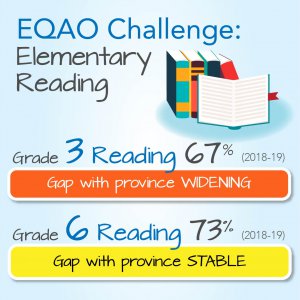 |
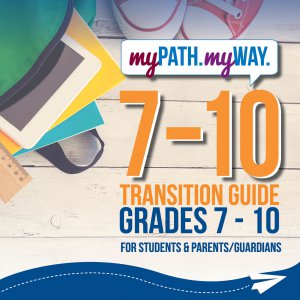 |
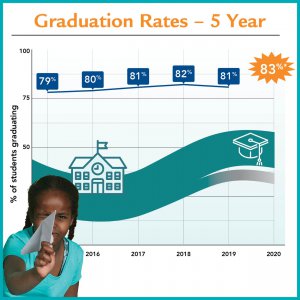 |
| HWDSB Sees Improvement in Student Reading and High Priority Schools | Students and families invited to Pathways Information Night | High School Graduation Rate Continues Above 80 per cent |
Effective Communication
We will improve our communication through comprehensive strategies.
Progress in 2018-19
Goal: Improve internal and external communications.
Target: Implement year one of the 2018-2021 Strategic Communications and Engagement Plan
Strategies:
- Mobilize knowledge for staff through a new intranet and staff directory. With input from staff across the district, the new myhome.hwdsb.on.ca is an improved version of the employee Intranet. It combines the latest Sharepoint features with custom resources used by the HWDSB community. Also, staff led and coordinated the re-launch of the staff directory. The QuickFinder had ended its run in the 2015-16 school year. Focus groups during the NSPRA Communication Audit in 2017 as well as during the creation of the Strategic Communications and Engagement Plan in 2018-19 revealed a strong sentiment from HWDSB employees that this internal resource was helpful. In January, 2019, after creating an internal practice to support the content of the directory, staff distributed approximately 2,000 copies. The QuickFinder helps staff connect with each other in schools and in the Education Centre, while supporting knowledge mobilization and production.
- Standardize digital platforms to improve communication with staff, parents and students. Staff initiated a strategy that would standardize digital platforms to improve communication with staff, parents and students. The purpose of this standardization is to improve internal and external communication and support the function with the appropriate tool to use. When staff know the platforms that HWDSB supports, staff can improve productivity and knowledge mobilization among staff, and enhance platforms for teacher/student use for educational purposes.
- Implement the Parent Portal for parents, guardians and caregivers in all schools. In 2018-19, the implementation of the Parent Portal was delayed due to the coming introduction of Unified Classroom in 2019-20. With this information, secondary schools continued to access the current Parent Portal in its current form. Once Unified Classroom is available, a communication plan will be created to announce the service to both elementary and secondary families.
Action Plan for 2019-20
Goal: Improve internal and external communications.
Target: Complete year two of the 2018-2021 Strategic Communications and Engagement Plan
Strategies:
- Implement standard digital platforms to improve communications with staff, parents and students. The Digital Engagement Advisory Committee is in the process of being formed and will host its first meeting in November. The committee will: Implement standard digital platforms and support transitions to improve communications with staff, parents and students; Discuss governance and functionality of internal and external web-based platforms/tools and applications; Implement a vetting process to review new and existing platforms and applications through a lens of Privacy, Program, Communications, Procurement and IIT; and review relevant guidelines, resources or procedures that support platform standardization.
- Implement an employee ambassador strategy. The employee ambassador strategy continues to be a focus and carries the work done in 2018-19 into this current school year. This strategy will continue to improve and create new practices that will enhance internal communications. Email guidelines and social media guidelines will be drafted. Human Resources Services and Communications and Community Engagement will collaborate on implementing employee orientation material and on-boarding supports. The Visual Identity program will be updated to reflect program, department and school identity in preparation for the revised implementation of the Strategic Direction. This strategy will lead to improvements in the HWDSB brand. By June 2020, staff will also embark on a proposal to Executive Council to explore a Customer Service program at HWDSB.
- Enhance digital engagement for external audiences through a story-telling strategy. In the year ahead, staff will create a structure for story-telling to share the positive experiences of students, staff and families within the community. Digital story-telling will include various forms of communication such as video and written articles to highlight students, partners, schools, programs and staff.
Staff are not on target to implement year two of the 2018-2021 Strategic Communications and Engagement Plan. *To date this year, department staff have provided, and continue to support, the crisis communication response from the tragic incident that took place on October 7, 2019. In addition, staff have supported communication during recent labour disruption and are preparing for the potential of future labour disruption. Strategies and execution of plans may be adjusted as year progresses.
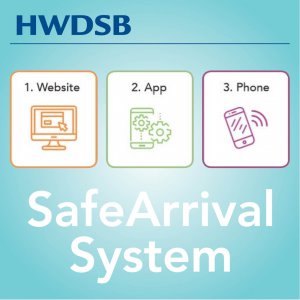 |
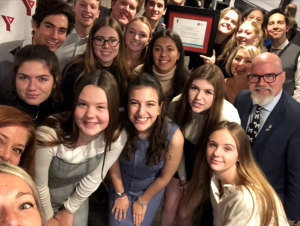 |
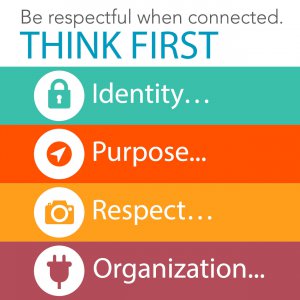 |
| A New Way to Report Student Absences | CHANGE the Way Student Conference | HWDSB celebrates digital citizenship |
School Renewal
We will optimize opportunities to invest in improved school facilities.
Progress in 2018-19
Goal: Improve the conditions of our schools.
Target: At least 25 per cent fewer schools will be identified as being in poor condition by 2020.
Strategies:
- Implement the annual capital plan included in the Long-Term Facilities Master Plan, which includes elementary and secondary facility benchmarks, school renewal, repairs and maintenance. In past years, projects were identified in the spring for summer completion, but moving this to November in 2018 allowed time for approvals. By not allocating all of the current year funding, this allowed staff to catch up and complete all of the identified projects.
- Work with municipal partners to ensure that the Board can proceed with the capital projects for which funding has already been received. As HWDSB and the city work more closely on timely approvals, Board staff are able to identify projects based on construction priorities and the city can clarify expectations so that approvals are not delayed by questions.
- Maximize funding received through Ministry of Education capital funding opportunities. Unfortunately, boards had no capital funding opportunities in 2018-19, so staff updated existing business cases to be ready for submission when opportunities exist.
Staff are on target to have at least 25 per cent fewer schools in poor condition by 2020
Action Plan for 2019-20
Goal: Improve the conditions of our schools.
Target: At least 25 per cent fewer schools will be identified as being in poor condition by 2020.
Strategies:
- Implement the annual capital plan included in the Long-Term Facilities Master Plan which includes elementary and secondary facility benchmarks, school renewal and repairs and maintenance.
- Work with municipal partners and the Ministry of Education to ensure that the Board can proceed with the capital projects for which funding has already been received.
- Maximize funding received from Ministry capital funding opportunities.
The report on this pillar was unavailable at the time of this report.
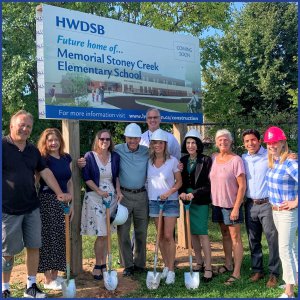 |
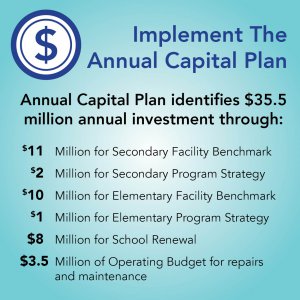 |
 |
| School Renewal Report | HWDSB Announces Move to Artificial Turf Fields at All Secondary Schools |
Partnerships
We will strengthen our collaboration with new and existing community partners to enhance opportunities for students.
Progress in 2018-19
Goal: All new and existing community partnerships will enhance opportunities for students.
Target: Establish a baseline of community partnerships that support student outcomes.
Strategies:
- Collect and analyze partnership data for the system and High Priority Schools. To refine the Partnership and Community Engagement (PACE) database, in fall 2018, staff met with system leaders to define partners and add them to the database of 251 entries. Staff will be able to know how many partners are in High Priority Schools and the alignment of partners with strategic directions.
- Align community partners’ goals with student needs in High Priority Schools. Staff collected and analyzed partnership data for the system and for High Priority Schools, to align partners’ goals with student needs in schools identified through a needs assessment.
Staff are on target to establish a baseline of community partnerships that support student outcomes.
Action Plan for 2019-20
Goal: All new and existing community partnerships will enhance opportunities for students.
Target: The number of community partnerships aligning to school needs will increase by August 2020.
Strategies:
- Implement a process to review and align the needs of schools and community partners.
- Continue to align the Hamilton Foundation for Student Success to support the focus on High Priority Schools.
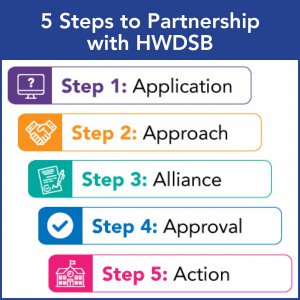
|
 |
 |
| Improving our Partnership Process | Foundation Expands Support for Students | ArcelorMittal Dofasco Partnership Supports Robotics and Coding |
Updated on Tuesday, December 14, 2021.

